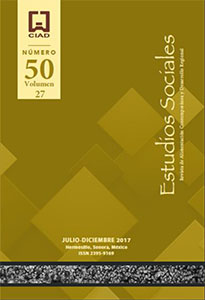Alimentación tradicional en la región del Maule de Chile. Representación de clientes y encargados de restaurantes tradicionales
Traditional food in the region of the Maule of Chile. Representation of clients and managers of traditional restaurants
Abstract
The article aims to elucidate the representation that have owners and customers, regarding the notion of food and traditional restaurant in the Maule region. Methodology. Qualitative study, exploratory and oriented theoretically and methodologically from the social representations. A structural sample composed of 14 restaurant owners considered as traditional, and 29 of its clients in the Maule region (Chile). A structured interview is applied. Results. These express that the notion of traditional restaurant, is composed by a historical valuation for both structural positions. Customers are represented as commensals, from the emergence of feelings associated to the familiarity, and the owners represent their condition, for pride and responsibility. Customers would recommend the premises for its gastronomic quality and tradition associate to the history of place. The owners would recommend their local for quality and public recognition. Limitations. It highlights as difficulty, the perception in the participants of the study, to consider the research as an evaluating aspect, therefore negative and fiscalizador of the place. Conclusions. It would be advisable to carry out a quantitative study to characterize the gastronomic offer and nutritional composition of foods in traditional restaurants in the region.
Keywords:
Contemporary food, sociology of food, social representations, traditional restaurant, traditional food, gastronomic offer, Chile.Abstract
The article aims to elucidate the representation that have owners and customers, regarding the notion of food and traditional restaurant in the Maule region. Methodology. Qualitative study, exploratory and oriented theoretically and methodologically from the social representations. A structural sample composed of 14 restaurant owners considered as traditional, and 29 of its clients in the Maule region (Chile). A structured interview is applied. Results. These express that the notion of traditional restaurant, is composed by a historical valuation for both structural positions. Customers are represented as commensals, from the emergence of feelings associated to the familiarity, and the owners represent their condition, for pride and responsibility. Customers would recommend the premises for its gastronomic quality and tradition associate to the history of place. The owners would recommend their local for quality and public recognition. Limitations. It highlights as difficulty, the perception in the participants of the study, to consider the research as an evaluating aspect, therefore negative and fiscalizador of the place. Conclusions. It would be advisable to carry out a quantitative study to characterize the gastronomic offer and nutritional composition of foods in traditional restaurants in the region.
Keywords:
Contemporary food, sociology of food, social representations, traditional restaurant, traditional food, gastronomic offer, Chile.Downloads
Published
How to Cite
Issue
Section
Para que sean publicados artículos, ensayos y reseñas críticas en Estudios Sociales, la revista debe contar con la aceptación de parte de los autores/autoras de las condiciones siguientes:
1. Los autores conservan los derechos de autor y ceden a la revista el derecho de la primera publicación del trabajo registrado bajo la licencia de Creative Commons Reconocimiento-NoComercial (CC-By-NC) que permite a terceros utilizar lo publicado, siempre y cuando mencionen la autoría del trabajo y a la primera publicación en esta revista.
2. Los autores pueden realizar otros acuerdos contractuales independientes y adicionales para la distribución no exclusiva de la versión del artículo publicado en esta revista (por ejemplo: incluirlo en un repositorio institucional o publicarlo en un libro) siempre y cuando indiquen, claramente, que el trabajo se publicó por primera vez en esta revista.




















